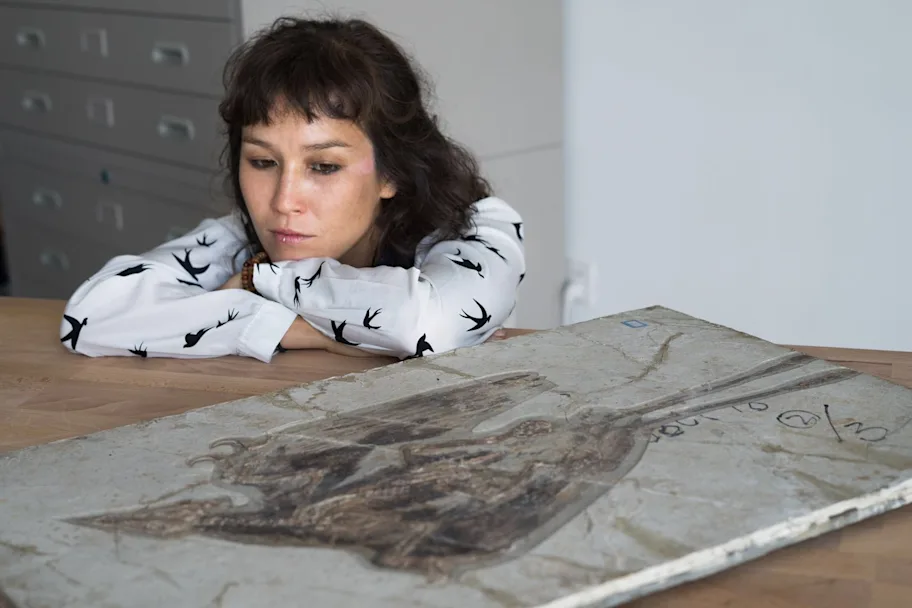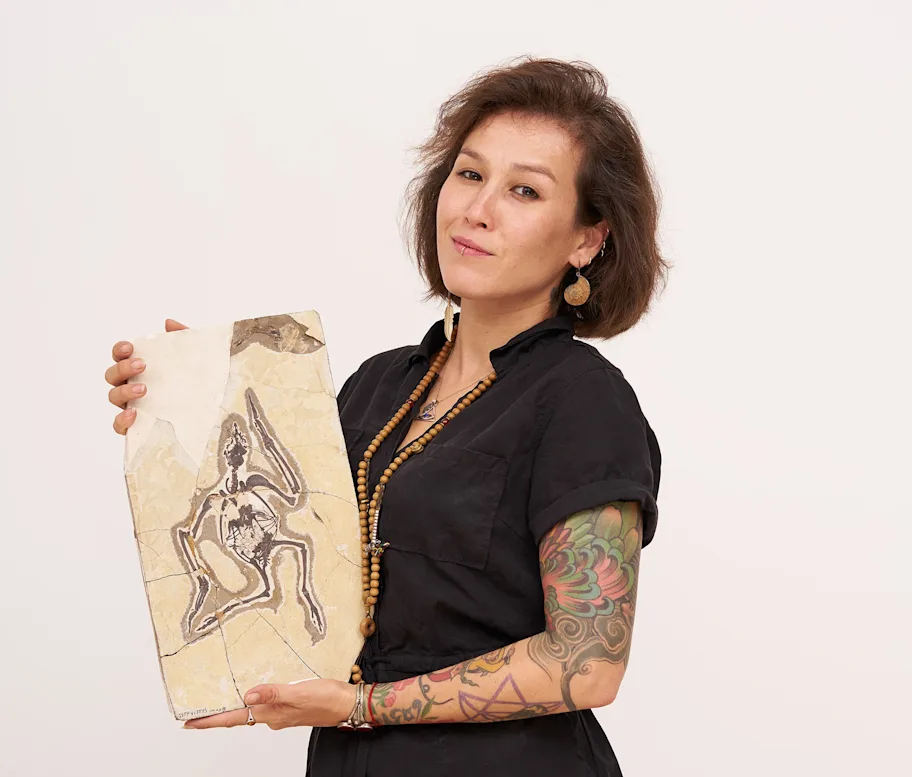- Science news
- Earth science
- Jingmai O’Connor: ‘I think people imagine we spend far more time digging up fossils than we actually do’
Jingmai O’Connor: ‘I think people imagine we spend far more time digging up fossils than we actually do’
By Colm Gorey, Frontiers science writer/Jingmai O’Connor

Jingmai O’Connor, associate curator of fossil reptiles at Chicago’s Field Museum. Image: Jesse Goldberg
Jingmai O’Connor, associate curator of fossil reptiles at Chicago’s Field Museum, discusses a recent ‘bizarre’ ancient digestive discovery and the issue of diversity in paleontology.
In a recently published study to Frontiers in Earth Science, researchers from the Chinese Academy of Sciences and the Field Museum in the US published findings on the discovery of quartz crystals in the stomach of a fossilized bird that lived alongside the dinosaurs.
According to Jingmai O’Connor, the associate curator of fossil reptiles at Chicago’s Field Museum who contributed to the paper, it appeared to be “some kind of bizarre form of soft tissue preservation that we’ve never seen before”.
She added: “Figuring out what’s in this bird’s stomach can help us understand what it ate and what role it played in its ecosystem.”
O’Connor is an American paleontologist whose research focuses on the dinosaur-bird transition and the Mesozoic evolution of birds and other flying dinosaurs. Her research includes studies of exceptional soft tissues, such as lung and ovary traces preserved in specimens from Jehel Biota between 130 million and 130 million years ago.
She has authored more than 100 papers and was the 2019 recipient of the Paleontological Society’s Charles Schuchert Award for outstanding paleontologist under 40.
O’Connor recently caught up with Frontiers to discuss her most recent research and her thoughts on the wider field of paleontology as part of our new series, Frontier Scientists’.
Because open access and sharing research is part of Frontiers’ mission, we want to give researchers the voice to express themselves and their research with more creativity and freedom than they otherwise would have in publishing an academic paper.
If you’ve recently published your paper with Frontiers and believe you have a great story to tell, then send an email to press@frontiersin.org with ‘Frontier Scientists’ and your name in the subject line.
What inspired you to become a researcher?
My mom did her PhD in earth sciences when I was a kid. I enjoyed going to the field with her, collecting rocks, minerals and fossils, and playing in the lab. I decided to also pursue geology and fell in love with paleontology in college through a professor named Don Prothero.
There were an astounding five students interested in paleo in one year – a huge number for a small liberal arts college. After giving us fair warning of the difficulties we would face if we pursued such a career, he provided us with every form of support available to him.
He contacted nearby colleagues to help me pursue my dream of studying Chinese fossils. This led to me volunteering at the LA Natural History Museum to learn how to prepare fossils, join their summer digs and going to China for field work while still an undergrad. He also encouraged me to apply for grants and gave us advice for grad school. In other words, he went above and beyond what is expected of a professor to give us a fighting chance of being successful in a highly competitive field and I will be forever grateful.
When I got into a PhD program, I had already experienced every aspect of paleontology and knew I was entering a field I was passionate about and enjoyed doing. Scientific research is, in my opinion, the best career possible. You’re an explorer of the unknown, pursuing knowledge for the benefit of humankind, seeking to understand the natural world.
Can you tell us about your most recent research published with Frontiers and it’s importance in the field of palaeontology?
I was approached by Frontiers to edit a special topic volume on early avian evolution and the recently published manuscript is the result of the master’s research of my student, Shumin Liu, at the Institute of Vertebrate Paleontology and Paleoanthropology.
It’s rather specialized, dealing specifically with purported stomach contents in an enantiornithine Bohaiornis from the rich Lower Cretaceous Jehol deposits in northeastern China. Modern birds have very advanced digestive systems and how this evolved is of great interest to me.
Based on ingested remains, we can reconstruct the structure of the digestive system in most Early Cretaceous avian lineages, but not enantiornithines. It’s really puzzling because in the Jehol there are far more specimens available for this group than any other, but no preserved ingested remains except for one specimen from the Early Cretaceous of Spain.
‘Scientific research is, in my opinion, the best career possible. You’re an explorer of the unknown’
Jingmai O’Connor
There are two specimens that have been suggested to preserve traces of diet but I have always disagreed with these interpretations as this was without real, tangible proof. Shumin set out to re-examine the purported gastroliths to test between the two competing hypotheses regarding their interpretation (gastroliths vs mineral precipitate) in this referred specimen of Bohaiornis.
The results indicate the traces in question are not gastroliths. Because we know so little about diet in enantiornithines, the dominant clade of Cretaceous land birds, every little trace matters. Gastroliths were utilized by most early avian lineages, but not enantiornithines – and confuciusornithiforms – and we still don’t understand why.
Enantiornithines, presumably, utilized a diversity of diets, so it’s odd some lineages didn’t evolve a gastric mill since this structure evolved multiple times both in non-avian dinosaurs and early birds – the genetic potential was clearly there. This study is just one tiny piece of data that lends itself to a larger question that is as yet unanswered.
What are some of the most common misconceptions about paleontology research and how do you try to remedy them?
I think people imagine that we spend far more time looking for and digging up fossils than we actually do. As a paleontologist, I spend 95% of my time in front of my computer. Research paleontologists come in so many different forms.
This includes those that spend far more time in the field; those that spend enormous amounts of time in laboratories doing chemistry, and those that write complex algorithms to tease patterns out of raw data. It’s the diversity of research done by paleontologists that I think people are unaware of.

Jingmai O’Connor, associate curator of fossil reptiles at Chicago’s Field Museum. Image: Jochen Stierberger
Does paleontology attract researchers from diverse backgrounds? If not, what advice would you have to those who feel they may not ‘fit in’?
Unfortunately, paleontology has been traditionally – and still to this day – been dominated by white men. This is improving with a far stronger female presence, but minority presence continues to be low and stories of females being mistreated by male advisors are not uncommon.
I think this mostly reflects much larger societal problems. The systematic disease of inequality that pervades our society is upheld by the system, which prevents meaningful change and protects ignorance and hate under the guise of free speech.
It is far more important to address the greater issue than to simply ask: “Why is paleontology white-male dominated?” If we address the larger problem, the effects will work their way down and issues regarding diversity in paleontology will also likely change. “Why is America still white-male dominated?” is the question we should all be asking, or perhaps more importantly “how can a system dominated by white males ever be expected to change itself and provide equality?” Those with power never give it up willingly and we kid ourselves if we think we can enact change within this inherently corrupt system.
If you have recently published your research with Frontiers and believe you have a story to tell, then you might feature as part of our new Frontier Scientists series! Send an email with the subject line ‘Frontier Scientists’ and your name to press@frontiersin.org , as well as details on what your most recent research was about.




